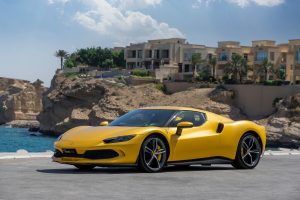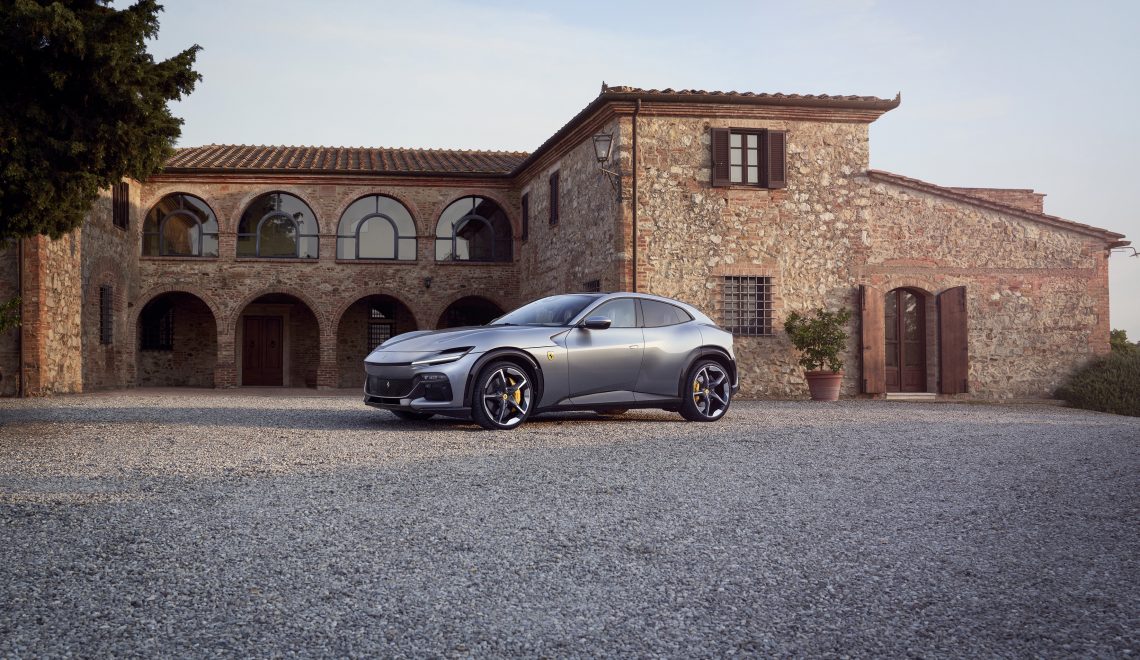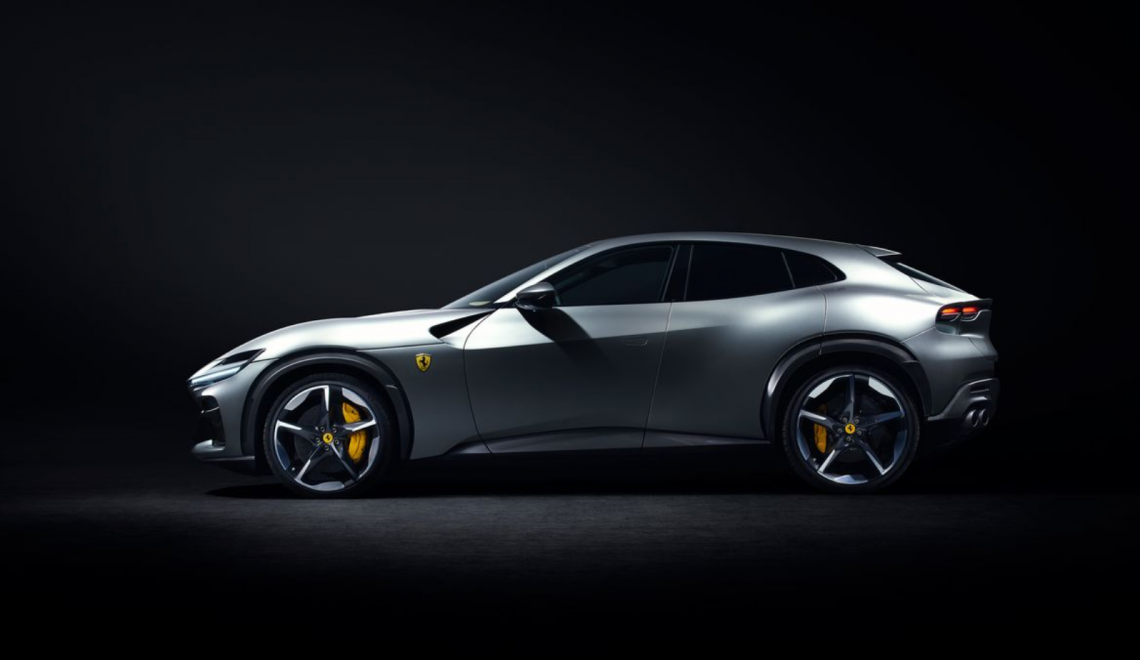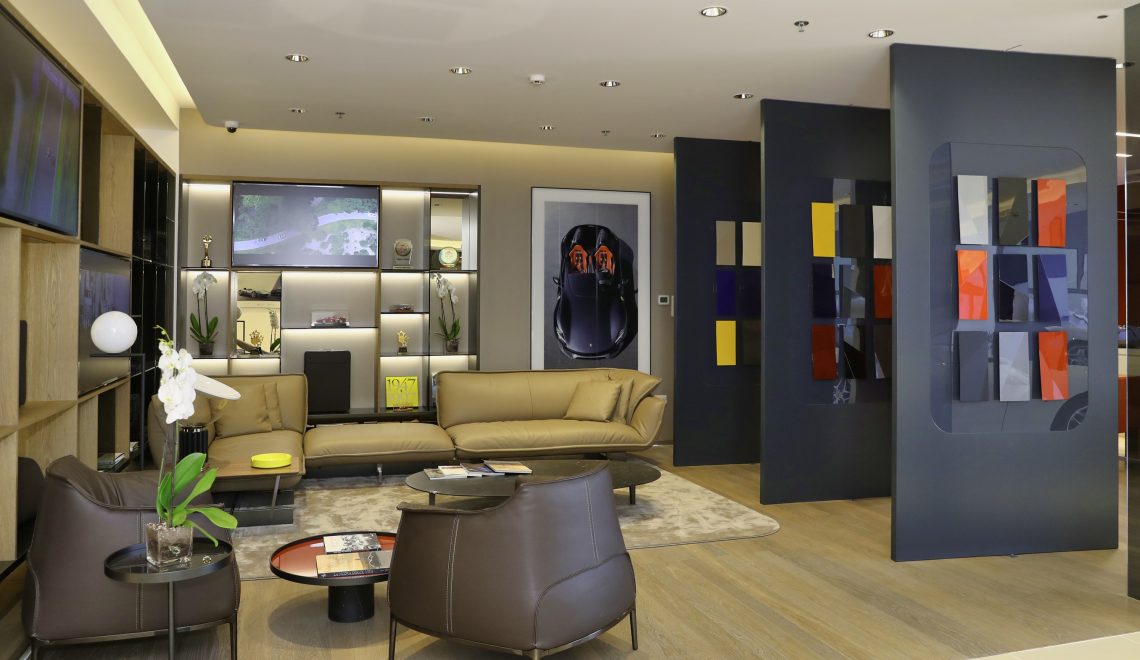From the Alfardan showroom to the scenic Qantab mountains, the Ferrari 296 GTB was a stallion on the beautiful roads of Oman. The 296 GTB, the latest evolution of Maranello’s mid-rear-engined two-seater berlinetta, was premiered today during an online event broadcast on Ferrari’s social media and web channels. The 296 GTB redefines the whole concept of fun behind the wheel, guaranteeing pure emotions not just when pushing the car to its limits, but also in day-to-day driving situations.
The 296 GTB ushers in an authentic revolution for Ferrari as it introduces a new engine type to flank the marque’s multi-award-winning 8- and 12-cylinder power units: a new 663 cv 120° V6 coupled with an electric motor capable of delivering a further 122 kW (167 cv). This is the first 6-cylinder engine installed on a road car sporting the Prancing Horse badge; it unleashes its massive 830 cv total power output to deliver previously unthinkable performance levels and an innovative, exhilarating and unique soundtrack.
The car’s name, which combines its total displacement (2992 l) and number of cylinders was chosen, with the addition of the GTB (Gran Turismo Berlinetta) acronym in finest Ferrari tradition, to underscore this new engine’s epoch-changing importance to Maranello. It is not simply the living, beating heart of the 296 GTB, but it also ushers in a new V6 era that has its roots deep in Ferrari’s unparalleled 70-year-plus experience in motor sports.
The very first Ferrari V6, in fact, featured a 65° architecture and debuted on the 1957 1500 cc Dino 156 F2 single-seater. This was followed in 1958 by bigger displacement versions on the front-engined sport prototypes – the 196 S and 296 S – and F1 cars, such as the 246 F1 which powered Mike Hawthorn to the F1 Drivers’ Championship title the same year.
The very first Ferrari to sport a mid-rear-mounted V6 was the 246 SP in 1961, which won the Targa Florio both that same year and in 1962, amongst many others. Also in 1961, Ferrari secured its first Constructors’ title in the Formula 1 World Championship with the 156 F1, which was powered by a 120° V6. Ferrari first installed turbos between an engine’s cylinder banks on the 126 CK in 1981 and subsequently on the 126 C2 in 1982, which became the first turbo-charged car to win the Formula 1 Constructors’ World Championship title. This was followed up with a second title in 1983 with the 126 C3. Lastly, V6 turbo hybrid architecture has been used on all Formula 1 single-seaters since 2014.
The 296 GTB’s plug-in hybrid (PHEV) system guarantees it is an incredibly usable car as well as cutting pedal response times to zero and delivering a 25km range in all-electric eDrive mode. The car’s compact dimensions and the introduction of innovative dynamic control systems as well as meticulously honed aero ensure that the driver will instantly experience its astonishing agility and responsiveness to commands. Its sporty, sinuous design and extremely compact dimensions also visually underscore its exceptional modernity, brilliantly referencing the likes of the 1963 250 LM, the perfect marriage of simplicity and functionality.
As was the case with the SF90 Stradale, for clients who want to exploit the car’s extreme power and performance to the utmost, particularly on the track, the 296 GTB is also available with the Assetto Fiorano package, which includes lightweight features and aero modifications.
Power Prowess
The 296 GTB is the first Ferrari road car to sport a V6 turbo with a vee with an angle of 120° between the cylinder banks, coupled with a plug-in electric motor. This new V6 has been designed and engineered from a clean sheet by Ferrari’s engineers specifically for this installation and is the first Ferrari to feature the turbos installed inside the vee. Aside from bringing significant advantages in terms of packaging, lowering the centre of gravity and reducing engine mass, this particular architecture helps deliver extremely high levels of power. The result is that the new Ferrari V6 has set a new specific power output record for a production car of 221 cv/l.
As the V6 turbo is integrated with an electric motor at the rear, the 296 GTB’s combined maximum power output is 830 cv, putting it at the top of the rear-wheel-drive sports car segment as well as making it extremely flexible. This is true both in terms of day-to-day contexts (the 296 GTB has a full-electric mode range of 25 km), and in driving enjoyment (accelerator pedal response is instant and smooth at all engine speeds).
The powertrain assembly comprises a V6 turbo ICE, with the 8-speed DCT and E-Diff, and the MGU-K located between the engine and the gearbox. A clutch is set between the ICE and the electric motor to decouple them in electric-only eDrive mode. Lastly there is a high-voltage battery and the inverter which controls the electric motors.
Combustion Engine Specs:
Thanks to its 663 cv and 221 cv/l, the 296 GTB’s ICE sets the new specific power output record for a production road car. Central to achieving this result was the introduction of the 120° vee configuration with equally-spaced firings as well as the positioning of the turbos inside the vee which produces a much more compact engine and optimally distributed masses.
The architecture is also ideal in terms of combustion sequence and the integration of the intake plenums and the engine supports on the intake sides of the cylinder heads. The engine is thus lighter and more compact because of the elimination of the plenums and exterior supports, while the fluid-dynamics benefit from the reduction in volumes, boosting intake efficiency. The 120° vee architecture, which offers more space between the cylinder banks than a 90° vee, meant the turbos could be installed centrally, thus significantly reducing the unit’s overall size and the distance the air has to cover to arrive in the combustion chamber, maximising the fluid dynamics and efficiency of the intake and exhaust line ducts.
To obtain this specific power output, the pressure in the combustion chamber had to be pushed to new heights. Boosting the pressure in the chamber demanded exceptional development from both a thermal-fluid-dynamic and structural point of view without compromising on engine weight and reliability. To that end, Ferrari poured all of its significant expertise in alloys, dimensioning and components into engineering the aluminium engine block and cylinder heads. Both components are new and specific to the new V6 architecture.
The distribution is completely new: drive is transmitted to the pump assembly (water and oil) via a timing chain and to the valvetrain via an offset sprocket and a dedicated timing chain per cylinder bank. The main chain has a dedicated hydraulic tensioner, two bush chains with relative hydraulic tensioner and different calibrations for right and left bank, as well as a dedicated chain for the oil pump assembly. The valvetrain, which has roller fingers with hydraulic tappets, has specific intake and exhaust valve profiles.
The engine benefited from the latest Ferrari combustion chamber development introduced on the SF90 Stradale: central injector and spark plug with 350-bar pressure injection system that improves the fuel-air mix in the chamber, performance and reduces emissions. The intake and exhaust ducts were redesigned and tuned to maximise volumetric efficiency and thus guarantee high levels of turbulence in the chamber.
The IHI turbochargers have been completely redesigned using higher performance alloys. This meant the maximum revs of the turbos could be increased to 180,000 rpm, with a consequent improvement in performance and boost efficiency, which increases by 24%. The symmetrical, couter-rotating turbos are of the mono-scroll type: the technical solutions adopted have reduced the compressor wheel diameter by 5% and the turbo rotor 11% compared to the V8 applications, despite the very high specific power. The reduction in the rotating masses (the inertia of the two rotating elements has been reduced by 11% compared to the 3.9l V8 solution) has reduced the spool up time ensuring instantaneous power delivery.
The crankshaft is made from nitrided steel. To ensure it has a 120° crank angle, after the initial forging of the rough ingot, the crankshaft is twisted and then subject to a deep nitriding heat treatments (to guarantee resistance to high loads), machining and balancing. The firing order of the new V6 (1-6-3-4-2-5) is the result of the crankshaft’s journal geometry. 100% of the rotating masses and 25% of the alternating masses are balanced, and therefore its level of balance allows loads on the bushings to be reduced without increasing the weight of the engine.
A new variable displacement oil pump was developed to guarantee that the oil pressure is continuously controlled right across the engine’s entire operating range. A solenoid valve, controlled by the engine ECU in a closed loop, is used to control the pump’s displacement in terms of flow and pressure, delivering only the amount of oil required to guarantee the functioning and reliability of the engine, whilst simultaneously providing a reduction in the power absorbed by the pump itself. On the oil scavenge side, to minimise splashing losses, the suction system was made more powerful using six scavenge rotors: three specific dedicated rotors for the crankcase below the crank throws, one for the distribution compartment and two for the cylinder head compartments.
In Ferrari engines, the intake plenum is normally located in the centre of the vee. However, the V6 hails a paradigm shift in that regard: its plenums are on the side of the cylinder heads and are integrated with the support for the throttle valve. The light thermoplastic material used to make them keeps engine weight down. This solution boosts performance because of the shorter ducts and consequent fluid-dynamic detuning, in addition to reducing time-to-boost as a result of the high pressure line’s smaller volume.
The new architecture also led to the development of a more linear exhaust line located in the upper part of the engine compartment. The shape of the exhaust reduces back pressure and contributes to boosting performance. The exhaust manifold and catalyser housings are made entirely from Inconel®, a steel-nickel alloy that reduces the weight of the exhaust and makes it more resistant to high temperatures.
Sound-wise, the 296 GTB rewrites the rulebook by harmoniously combining two characteristics that are normally diametrically opposed: the force of the turbos and the harmony of the high-frequency notes of a naturally-aspirated V12. Even at low revs, inside the cabin, the soundtrack features the pure V12 orders of harmonics which then, at higher revs, guarantee that typical high-frequency treble. This Ferrari’s soundtrack matches its performance, creating a sense of unprecedented involvement, and marking the turning of a new page in Maranello’s berlinetta history.
Even to those outside the car, the shrill sound of the engine is instantly recognisable. The first in the F163 engine family, this V6 earned itself the nickname “piccolo V12” (little V12) during the development phase. The 120° V architecture guarantees a symmetrical firing order while the equal-length, tuned exhaust manifolds combined with the single exhaust line outside the hot-V amplify the pressure waves. These characteristics are what lend such purity to the orders of harmonics, which are further helped by a limiter that hits an impressive 8500 rpm. The patented “hot tube” has been completely redesigned for the 296 GTB and is positioned prior to the exhaust gas treatment systems so that it channels the pure sound into the cabin, further enhancing driver involvement and excitement.
Hybrid EV
This is the first ever Ferrari with a rear-wheel drive-only PHEV (Plug-in Hybrid Electric Vehicle) architecture in which the ICE is integrated with a rear-mounted electric motor producing up to 122 kW (167 cv) derived from the Formula 1 application from which it also inherits the MGU-K (Motor Generator Unit, Kinetic) moniker. The electric motor and ICE communicate via the Transition Manager Actuator (TMA) which allows them to be used both together to produce a combined power output of 830 cv or decouples them to allow the electric motor to run solo.
Aside from the V6 turbo and the 8-speed DCT already adopted on the SF90 Stradale, Ferrari Roma, Portofino M and the SF90 Spider, the powertrain architecture also includes the MGU-K electric motor positioned between the engine and gearbox, the TMA to decouple the electric motor from the ICE, the 7.45 Kwh high voltage battery, and the inverter which controls the electric motors.
The MGU-K is a dual-rotor single-stator axial flux motor. Its compact size and its structure allowed the length of the powertrain to be reduced which, in the final analysis, helped shorten the 296 GTB’s wheelbase. The electric motor charges the high voltage battery, turns on the ICE, supplies it with additional torque and power (up to 167 cv) and allows the car to be driven in all-electric eDrive mode. The MGU-K’s improved design allows it to reach maximum torque of 315 Nm, around 20% more than previous applications.
The TMA (Transition Manager Actuator) allows very rapid static and dynamic transitions from electric to hybrid/ICE mode and vice-versa, thereby guaranteeing smooth, progressive torque. Its control software, which was developed entirely in-house by Ferrari, communicates with the DCT, motor and inverter software to more efficiently manage ICE ignition and its connection and disconnection to the transmission. Thanks to new generation components, the TMA allowed the design of an incredibly compact transmission: the system has an overall impact on the length of the powertrain of just 54.3 mm. Its architecture comprises a triple-plate dry clutch, a clutch command module in line with the driveline with a clutch control linkage, and ECUs.
Thanks to an innovative design manufactured using laser welding, the 296 GTB’s high voltage battery has a 7.45 kWh capacity and a competitive weight/power ratio. The battery pack is located under the floor and to minimise volume and weight, the cooling system, structure and fixing points are integrated into a single component. The cell modules contain 80 cells connected in series. Each Cell Supervisor Controller is installed directly in the modules to reduce volume and weight.
The 296 GTB’s inverter is based on two silicon modules connected in parallel, the power deliver mode of which has been optimised to achieve the MGU-K’s torque increase to 315 Nm. This component converts the electric energy with an extremely high level of efficiency (over 94%) and can supply the power required to start the V6 even when there is maximum demand for electric power.
Aerodynamics
The 296 GTB bursts into the mid-engined berlinetta sports car range, with several radical and innovative solutions. The turbo has been installed above the vee of the crankcase in a hot-V configuration. This means that all of components most critical to heat generation are clustered in the upper centre area of the engine bay, which in turns allows more efficient heat management both of the engine bay itself and of the electrical components. This sharp break from the past is further highlighted by aero choices, which have turned the active aero paradigm introduced from the 458 Speciale onwards, on its head. On the 296 GTB, for the first time, an active device is being used not to manage drag but to generate extra downforce. The LaFerrari-inspired active spoiler integrated into the rear bumper allows the 296 GTB to generate a high level of rear downforce when required: the equivalent of a maximum of 360 kg at 250 km/h in high-downforce configuration with the Assetto Fiorano package.
This impressive performance was achieved by seamlessly optimising the car’s volumes. The result is a car with an extremely clean, elegant design in which all the performance-oriented elements meld effortlessly with the styling, underscoring the inextricable marriage of technology and aesthetics that is the signature of all Ferraris. The aero development work done on the 296 GTB means that even in low-drag configuration the car can deliver more downforce than previous applications. In high-downforce configuration, there is an additional 100 kg in downforce thanks to the active spoiler.
The ICE and the gearbox are cooled by two radiators installed at the front of the car, ahead of the front wheels, where there are also two condensers for the high-voltage battery cooling. The hot air is evacuated along the underbody, to avoid it interfering with the cooling air to the intercoolers along the upper part of the flanks. This choice made it possible to maximise efficiency and thus minimise the size of the air intake, further streamlining the car’s already clean styling. The radiators for the hybrid system have been given two vents just below the side sections of the spoiler. This solution frees up the central part of the front of the car, which has thus been used to generate downforce, and optimises the routing of the various circuits, to the direct benefit of packaging and weight.
The engine bay incorporates both the usual ICE components, which can function at peak temperatures of over 900 ° Celsius, and electric and electronic components that must function at lower temperatures. This led to a complete redesign of the turbo layout and the entire exhaust line.
The brake cooling system was developed around the Aero callipers introduced on the SF90 Stradale with ventilation ducts integrated into their castings. This brake cooling concept requires a dedicated duct to correctly channel cool air coming in through the air intakes on the front bumper through the wheelarch. In the case of the 296 GTB, the intake has been integrated into the headlight design. Just below the DRL, on the inner section, an aperture connects the wing to the wheelarch via a duct running parallel to the chassis strut, thus providing the cool air to the brakes.
This made it possible to push the design of the car’s underbody to new extremes, increasing the cooling capacity of the underbody without having to adopt any active front aero mechanisms. The signature aerodynamic element at the front of the 296 GTB is the ‘tea-tray’. The arrangement of the radiating masses at the sides of the car frees up a central volume into which the tea tray is set, framed by the bridge that perfectly integrates it into the architecture and styling of the front bumper. This aero device uses a concept widely applied to single-seaters: the rear surface of the bumper works in synergy with the upper surface of the tea tray to create a high overpressure field, which counteracts the depression field that characterises the underbody.
The two different pressure regions remain separate as far as the edges of the tea-tray. But at those points, the two fields of opposing pressure come together once again and the air flow rolls back on itself creating an extremely coherent and energised vortex that is directed below the underbody. The vortex movement of the air translates into a localised acceleration of the flow that produces a high level of suction and greater downforce over the front axle.
Looking at the car from the front, the side volume creases sharply inwards, almost folding up over the side splitter. The empty volume thus created allows the flow to be more efficiently channelled and maximises the flow of air in the lower part of the bumper. To exploit the potential of the flow striking the side splitter to the fullest, the bumper ahead of the wheel is completed by a vertical nolder which generates a local recompression area that increases downforce and increases the extraction capacity of the hot air from the radiators. Also on the side of the bumper, the side air curtain channels the air from the front part of the bumper towards the wheel well, so that it vents through a specially created opening in the wheelarch. The exit section of this duct is calibrated to contain the transverse expansion of the wake.
The most significant modification to the central section was a localised lowering of the surfaces to the minimum height permitted under homologation requirements. This brought the underbody closer to the road, exaggerating the suction created as a result of ground effect, as well as front downforce. Immediately downstream of the lowered central area, the underbody has been slightly raised above the minimum height to maximise the quality of air flowing between the underbody and the ground, and also to expose more of the vertical surfaces of the vortex generator strakes. Their specific geometry and effect on the rear underbody guarantee that the car remains correctly balanced in all dynamic driving conditions.
The adoption of the ‘Aero’ brake callipers allowed the dedicated cooling system to be created without an intake duct under the suspension arm. The extra space freed up was used to widen the flat underbody in that area, which increased the downforce generating surface, and also to add an extra vortex generator with an innovative L section.
The styling of the tail hails an unequivocal break from traditional Ferrari coupé design by adopting an architecture that creates a spider-like discontinuity between roof and rear engine cover. This choice makes the 296 GTB both unique and instantly recognisable and, from an aerodynamic perspective, led to the addition of a new wing profile on the roof which extends into two side fins that hug the edges of the rear engine cover
The main aerodynamic signature of the rear of the 296 GTB is an active spoiler that generates extra downforce and maximises the car’s handling and braking performance at high speeds. The active aero concept is actually diametrically opposed to the one introduced on the Ferrari’s berlinettas from the 458 Speciale onwards. In previous applications, flaps on the diffuser allowed a transition from a high-downforce (HD) configuration to a low-drag (LD) one that allowed maximum speed to be reached on the straight. However, on the 296 GTB, when the active aero device is deployed it increases downforce.
The active rear spoiler is seamlessly integrated into the bumper design, taking up almost all of the space between the taillights. When maximum downforce is not required, the spoiler is stowed in a compartment in the upper section of the tail. But as soon as acceleration figures, which are constantly monitored by the car’s dynamic control systems, exceed a specific threshold, then the spoiler deploys and extends from the fixed section of the bodywork. This combined effect results in a 100 kg increase in downforce over the rear axle which enhances the driver’s control in high-performance driving situations and also minimises stopping distances under braking.
To avoid compromising the functioning of the rear of the car, it was essential to guarantee that the flow over the rear remained extremely efficient in both low drag and high downforce conditions. Not having a rear screen running from the trailing edge of the roof to the tail meant that the flow separation from the roof had to be meticulously managed, by creating a virtual fairing that would allow the air flow over the roof to strike the rear of the car correctly, as if it were being channelled by an actual but invisible rear screen. This is how the very successful duo comprising the wing profile and consequent blown area over the end section of the cabin work. The latter was a detail specifically calibrated during CFD development and then validated in the wind tunnel.
The significant development of the front required the effect on the rear to be counterbalanced in low drag configuration i.e. when downforce over the rear does not benefit from the extra 100 kg. In this regard, the designers fully exploited the opportunities opened up by the layout of the exhaust line which clustered the main heat sources in the upper part of the engine compartment. This allowed the ventilation apertures for the components under the cover to be optimised, thereby clawing back large surfaces for downforce generation, particularly in the central area under the engine, which avoided damaging impacts on the efficiency of the underbody flow.
Because the flow upstream from it is so efficient, the diffuser has a very clean, linear design that is in perfect symbiosis with the upper section of the rear bumper. The central channel of the diffuser is characterised by a double kink line. Thanks to this device, it is possible to modify the direction in which the flow sucked along the underbody is released into the car’s wake, thereby containing the vertical expansion of the car’s wake and thus drag.
Styling
Exterior
The Ferrari 296 GTB’s design is the result of the desire of the Ferrari Styling Centre to redefine the identity of the mid-rear-engined two-seater berlinetta by giving it an extremely compact line with an original, modern look. Thanks to its short wheelbase and its monolithic, sculpted structure, the 296 GTB is indeed the most compact berlinetta to emerge from Maranello in the last decade. The typical berlinetta fastback configuration has been abandoned in favour of creating a cabin architecture that visually seems set into an imposing volume – the combined effect of the short wheelbase and the composition of elements, such as very muscular wings, the visor-style windscreen, robust flying buttresses and a new vertical rear screen. These forms produce a highly original cabin silhouette that dominates the overall perception of the car.
The 296 GTB’s impeccably clean, simple architecture seems the work of a single pencil stroke. There are neither artificial optical effects designed to lighten the car’s volumes nor stark colour contrasts. Instead the designers chose the most convincing archetype to give the car a unique identity all of its own, so unique it rewrote the entire rulebook by rediscovering the most authentic principles of Italian car design. Its clean forms and interlocking volumes enhance the 296 GTB’s uncompromisingly sporty character, ensuring it is the worthy heir to a philosophy that can be traced back to the very roots of Ferrari tradition. Its exceptional modernity references 1960s’ Ferraris, which made simplicity and functionality their signatures. The 250 LM from 1963, in particular, provided the designers with inspiration through elements such as the sinuous, sculpted look of the body, the design of the B pillar, the unusual composition of the wings into which the air-intakes are set, and the delicately proportioned Kamm tail.
One of the most recognisable aspects of the 296 GTB’s design is its cabin, which has a visor-style windscreen that wraps around onto the side windows. Already adopted on several limited-edition Ferraris, including the J50, and one-offs, such as the P80/C, this theme has now reached its maximum expression on a road car. The wraparound theme at the front connects organically to the flying buttress theme at the rear, together with a transparent engine cover that showcases the engine.
The 296 GTB’s aesthetic and performance prowess are instantly clear at the first glance of the car from the rear three-quarters. The powerful relationship between body and cabin is emphasised by the cut line of the roof, the conformation of the flying buttresses and the muscle of the wings. The result is a very compact car in which the cabin is visually inset into the surrounding volumes.
The 296 GTB reveals all of its elegance in the side view, which is characterised by the sinuous muscle of the wings. A clear, strong crease line runs along the doors and melds with the large air intakes positioned at the most aerodynamically efficient point. The cylindrical volume of the air intakes gives rise to the protrusion of the muscular rear wing. The cross section of the rear wing was meticulously designed to guarantee that the air flow to the spoiler was sufficient to deliver the high aerodynamic performance required of this car.
The 296 GTB’s front volumes are very pure, clean and extremely compact, a result that demanded meticulous honing of the geometry of the surfaces. Compared to previous mid-rear engine V8 models, the front of the 296 GTB is much more tapered. Seen from above, the crest of the front wing delineates the entire perimeter of the front of the car, creating a styling theme that elegantly divides the functions of the headlight assemblies.

The headlights take their inspiration from the “teardrop-shaped” headlights of the past. On the 296 GTB, this styling theme is interpreted through two “faired-in teardrops” which are set into the front of the car like jewels. The effect is completed by the formal composition of the DRL, which acts as the signature of the front of this car, and the brake air intake. The central single-grille styling theme has been given a new twist by reducing the height of the grille in the centre. The result is a bar-bell shape which hints at the presence of the two powerful radiators. In the central section is a compact suspended wing, reminiscent of solutions adopted in F1.
The upper surface of the ultramodern tail is dominated by an imposing flying buttress. At its base, it incorporates the engine bay cover which has a unique, three-dimensional glass surface. The central section features a striking body-coloured element that references a styling theme dear to Maranello that can be traced all the way back to the iconic likes of the Ferrari Testarossa and F355 GTB.

The 296 GTB’s other rear-end styling feature is its Kamm tail, a surface carved out of a solid volume, that underscores the car’s compact volumes. The upper section of the tail also incorporates a horizontal element that incorporates the taillights and integrated retracting spoiler. With the lights off, a thin “black screen” line runs horizontally the entire width of the rear. When the taillights are on, two strips of light appear on either end of the rear. The designers chose to reinterpret the traditional twin round taillights by incorporating the other light functions in two semi-circular indents in the rear surface below the side lights.
The 296 GTB features a single central exhaust tailpipe – a modern touch. The exhaust design completes the lower part of the profile of the centre of the bumper, which extends upwards to the taillights at either end, thereby emphasising the horizontal feel of the rear of the car. The central wing is stowed in the bodywork between the taillights and completes the design. This integrated solution is the perfect marriage of functionality, technology and design, guaranteeing that the aerodynamic performance required is delivered without sullying the purity of the design.
The 296 GTB sports a new alloy wheel with a twin-spoke design that accentuates the sculptural effect of the starburst shape. There are also specific five-spoke forged wheels where the effect is highlighted by a diamond-cut finish. Each of the five main spokes is twinned with a second, dynamic, curved element, creating a slot between them that improves air extraction from the wheelarch. There is also the carbon-fibre wheel option, which is 8 kg lighter than their forged counterpart and sets a whole new performance benchmark.
Cockpit
The 296 GTB’s cockpit was developed around the new concept of an entirely digital interface which Ferrari first debuted on the SF90 Stradale. This interior layout draws on the latter’s stylistic coherence for its forms. While with the SF90 Stradale the designers wanted to highlight the presence of the advanced technology and underscore a clear break with the past; in the case of the 296 GTB, the idea was to clothe that technology in a sophisticated way. The result is a pure, minimalistic connotation characterised by a powerful elegance that, on an aesthetic level, perfectly mirrors the design of the exterior.
The 296 GTB’s cabin raises the concept of the formal purity of the functional elements to new heights. From a formal perspective, when the engine is off, the onboard instruments go black, enhancing the minimalist look of the cabin. Exclusive Italian leather trim to the seats and trim is further enhanced by the noble technical materials used on the functional components.
Once the capacitive ‘Start Engine’ button is touched, all of the components gradually spring to life and the 296 GTB reveals its technological glory in the form of an exceptionally modern, ergonomic and completely digital interface. The main instrument cluster is set into a deep cleft carved out of the dashboard trim, itself characterised by a deliberately clean, taut surface. From this styling solution emerges the steering wheel and the instrument cluster supported by two visible structural supports, which taper seamlessly into the dashboard. Completing the picture are two side satellites, each with its own capacitive touch area, and an air vent. The passenger side is very minimalistic with the standard passenger-side display, allowing them to live the driving experience very much as a participant, almost a co-driver.
The sculptural door panel is a seamless continuation of the dashboard in terms of both materials and colour. On the central medallion, the styling cue is a deep lozenge-shaped scoop, a three-dimensional element. This type of architecture makes the entire door panel look extremely light and integrates the theme that connects it to the rear trim. The tunnel incorporates the SF90 Stradale-inspired modern take on the classic gear-shift gate and a compartment for stowing the ignition key with its characteristic Prancing Horse badge. For the 296 GTB, the designers created specific diapason-style seats using contrasting grooves which coordinate aesthetically with the edge strip of the instrument cluster.
An example of the application of Ferrari’s philosophy of maximum formal purity is the HUD (Head Up Display) which is integrated into the leather trim. The design of the speakers follows the same principle. Rather than metal, the designers have opted for a thermoplastic cover in the same colour as the dash.







